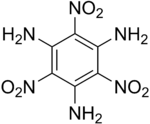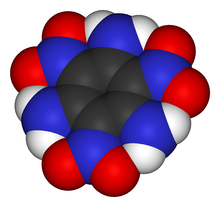226:
151:
35:
44:
427:
108:
776:
Mitchell, Alexander R.; Coburn, Michael D.; Schmidt, Robert D.; Pagoria, Philip F.; Lee, Gregory S. (2002). "Advances in the chemical conversion of surplus energetic materials to higher value products".
625:
651:
582:
TATB has a crystal density of 1.93 grams/cm, though most forms currently in use have no higher density than 1.80 grams/cm. TATB melts at 350 °C. The chemical formula for TATB is C
678:, is reacted with TMHI it is aminated to TATB. Thus, materials that would have to be destroyed when no longer needed are converted into a high value explosive.
440:
567:
mixtures or other use forms, the applications for such forms would be unclear since they would largely undo the insensitivity of pure TATB.
521:. Because it is so difficult to detonate by accident, even under severe conditions, it has become preferred for applications where extreme
542:
275:
529:, where accidental detonation during an airplane crash or rocket misfiring could potentially detonate the fissile core. All British
663:
557:
836:
816:
749:
240:
608:
TATB has been found to remain stable at temperatures at least as high as 250 °C for prolonged periods of time.
716:
447:
650:
Still another process has been found for the production of TATB from materials that are surplus to military use.
635:
However, it is likely that the production of TATB will be switched over to a process involving the nitration and
435:
751:
Conversion of the Rocket
Propellant UDMH to a Reagent Useful in Vicarious Nucleophilic Substitution Reactions
831:
183:
146:
204:
692:
549:
221:
621:
564:
534:
479:
730:
629:
393:
192:
128:
56:
84:
8:
403:
74:
225:
150:
758:
518:
790:
841:
812:
644:
522:
506:
383:
21:
762:
786:
409:
298:
172:
530:
502:
640:
636:
538:
526:
418:
825:
659:
368:
139:
748:
Mitchell, Alexander R.; Pagoria, P. F.; Schmidt, R. D. (10 November 1995).
346:
34:
675:
563:
Though it could theoretically be mixed with other explosive compounds in
471:
249:
InChI=1S/C6H6N6O6/c7-1-4(10(13)14)2(8)6(12(17)18)3(9)5(1)11(15)16/h7-9H2
654:(TMHI) is formed from the rocket fuel unsymmetrical dimethylhydrazine (
576:
332:
259:
InChI=1/C6H6N6O6/c7-1-4(10(13)14)2(8)6(12(17)18)3(9)5(1)11(15)16/h7-9H2
119:
697:
671:
667:
617:
510:
417:
Except where otherwise noted, data are given for materials in their
643:, since this process is milder, cheaper, and reduces the amount of
107:
475:
354:
159:
552:
compositions, such as PBX-9502, LX-17-0, and PBX-9503 (with 15%
497:
TATB is a very powerful explosive (somewhat less powerful than
43:
687:
487:
97:
775:
757:(Technical report). Lawrence Livermore National Laboratory.
209:
655:
514:
360:
17:
553:
498:
747:
575:
At a pressed density of 1.80, TATB has a velocity of
548:
TATB is normally used as the explosive ingredient in
823:
494:) groups attached, alternating around the ring.
171:
83:
728:
719:, UK MOD position statement, 23 January 2006
647:salt produced in waste effluents (greener).
525:is required, such as the explosives used in
224:
149:
127:
474:explosive, based on the basic six-carbon
191:
722:
556:). These formulations are described as
220:
824:
731:"South Africa and the Affordable Bomb"
560:(IHEs) in nuclear weapons literature.
505:), but it is extremely insensitive to
373:350 °C (662 °F; 623 K)
140:
632:with amine groups using ammonolysis.
626:1,3,5-trichloro-2,4,6-trinitrobenzene
605:Pure TATB has a bright yellow color.
252:Key: JDFUJAMTCCQARF-UHFFFAOYSA-N
545:used TATB to increase their safety.
468:2,4,6-triamino-1,3,5-trinitrobenzene
61:2,4,6-Trinitrobenzene-1,3,5-triamine
664:vicarious nucleophilic substitution
533:use TATB-based explosives in their
345:Yellow or brown powdered crystals (
262:Key: JDFUJAMTCCQARF-UHFFFAOYAO
162:
13:
14:
853:
735:Bulletin of the Atomic Scientists
652:1,1,1-trimethylhydrazinium iodide
283:c1(c(c(c(c(c1(=O))N)(=O))N)(=O))N
674:, which is easily produced from
425:
316:
310:
42:
33:
421:(at 25 °C , 100 kPa).
811:, New York: Wiley-VCH, 1996.
769:
741:
710:
628:, then the chlorine atoms are
543:South Africa's nuclear weapons
322:
304:
1:
801:
791:10.1016/S0040-6031(01)00806-1
611:
570:
729:David Albright (July 1994).
579:of 7,350 meters per second.
7:
681:
558:insensitive high explosives
10:
858:
478:ring structure with three
337:258.15 g/mol
15:
415:
377:
291:
271:
236:
67:
55:
50:
41:
32:
837:Nitrobenzene derivatives
717:Memorandum from Prospect
703:
693:Plastic bonded explosive
550:plastic bonded explosive
16:Not to be confused with
480:nitro functional groups
464:triaminotrinitrobenzene
809:Explosives Engineering
622:1,3,5-trichlorobenzene
20:, a highly sensitive
616:TATB is produced by
394:Friction sensitivity
57:Preferred IUPAC name
832:Explosive chemicals
404:Detonation velocity
29:
779:Thermochimica Acta
448:Infobox references
27:
807:Cooper, Paul W.,
765:. UCRL-JC-122489.
645:ammonium chloride
456:Chemical compound
454:
453:
384:Shock sensitivity
205:CompTox Dashboard
109:Interactive image
22:primary explosive
849:
795:
794:
785:(1–2): 205–217.
773:
767:
766:
756:
745:
739:
738:
726:
720:
714:
662:, and acts as a
537:. According to
531:nuclear warheads
501:, but more than
438:
432:
429:
428:
324:
318:
312:
306:
299:Chemical formula
229:
228:
213:
211:
195:
175:
164:
153:
142:
131:
111:
87:
46:
37:
30:
26:
857:
856:
852:
851:
850:
848:
847:
846:
822:
821:
804:
799:
798:
774:
770:
754:
746:
742:
727:
723:
715:
711:
706:
684:
614:
601:
597:
593:
589:
585:
573:
527:nuclear weapons
493:
485:
457:
450:
445:
444:
443: ?)
434:
430:
426:
422:
378:Explosive data
327:
321:
315:
309:
301:
287:
284:
279:
278:
267:
264:
263:
260:
254:
253:
250:
244:
243:
232:
214:
207:
198:
178:
165:
134:
114:
101:
90:
77:
63:
62:
25:
12:
11:
5:
855:
845:
844:
839:
834:
820:
819:
803:
800:
797:
796:
768:
740:
721:
708:
707:
705:
702:
701:
700:
695:
690:
683:
680:
670:reagent. When
641:phloroglucinol
637:transamination
613:
610:
599:
595:
591:
587:
583:
572:
569:
539:David Albright
491:
483:
455:
452:
451:
446:
424:
423:
419:standard state
416:
413:
412:
406:
400:
399:
396:
390:
389:
386:
380:
379:
375:
374:
371:
365:
364:
357:
351:
350:
343:
339:
338:
335:
329:
328:
325:
319:
313:
307:
302:
297:
294:
293:
289:
288:
286:
285:
282:
274:
273:
272:
269:
268:
266:
265:
261:
258:
257:
255:
251:
248:
247:
239:
238:
237:
234:
233:
231:
230:
217:
215:
203:
200:
199:
197:
196:
188:
186:
180:
179:
177:
176:
168:
166:
158:
155:
154:
144:
136:
135:
133:
132:
124:
122:
116:
115:
113:
112:
104:
102:
95:
92:
91:
89:
88:
80:
78:
73:
70:
69:
65:
64:
60:
59:
53:
52:
48:
47:
39:
38:
9:
6:
4:
3:
2:
854:
843:
840:
838:
835:
833:
830:
829:
827:
818:
817:0-471-18636-8
814:
810:
806:
805:
792:
788:
784:
780:
772:
764:
760:
753:
752:
744:
737:. p. 44.
736:
732:
725:
718:
713:
709:
699:
696:
694:
691:
689:
686:
685:
679:
677:
673:
669:
665:
661:
660:methyl iodide
657:
653:
648:
646:
642:
638:
633:
631:
627:
623:
619:
609:
606:
603:
580:
578:
568:
566:
561:
559:
555:
551:
546:
544:
540:
536:
535:primary stage
532:
528:
524:
520:
516:
512:
508:
504:
500:
495:
489:
481:
477:
473:
469:
465:
461:
449:
442:
437:
420:
414:
411:
407:
405:
402:
401:
397:
395:
392:
391:
387:
385:
382:
381:
376:
372:
370:
369:Melting point
367:
366:
362:
358:
356:
353:
352:
348:
344:
341:
340:
336:
334:
331:
330:
303:
300:
296:
295:
290:
281:
280:
277:
270:
256:
246:
245:
242:
235:
227:
223:
222:DTXSID8062818
219:
218:
216:
206:
202:
201:
194:
190:
189:
187:
185:
182:
181:
174:
170:
169:
167:
161:
157:
156:
152:
148:
145:
143:
141:ECHA InfoCard
138:
137:
130:
126:
125:
123:
121:
118:
117:
110:
106:
105:
103:
99:
94:
93:
86:
82:
81:
79:
76:
72:
71:
66:
58:
54:
49:
45:
40:
36:
31:
23:
19:
808:
782:
778:
771:
750:
743:
734:
724:
712:
649:
634:
615:
607:
604:
581:
574:
562:
547:
496:
486:) and three
467:
463:
459:
458:
398:Insensitive
388:Insensitive
347:rhombohedral
68:Identifiers
676:Explosive D
630:substituted
342:Appearance
292:Properties
147:100.019.362
826:Categories
802:References
612:Production
577:detonation
571:Properties
333:Molar mass
193:CJP3UNX7Z7
120:ChemSpider
96:3D model (
75:CAS Number
698:RE factor
672:picramide
668:amination
618:nitration
511:vibration
85:3058-38-6
842:Anilines
763:54794595
682:See also
565:castable
472:aromatic
476:benzene
441:what is
439: (
355:Density
160:PubChem
815:
761:
666:(VNS)
658:) and
523:safety
519:impact
470:is an
436:verify
433:
276:SMILES
51:Names
759:S2CID
755:(PDF)
704:Notes
688:FOX-7
517:, or
507:shock
488:amine
408:7350
359:1.93
241:InChI
173:18286
129:17272
98:JSmol
28:TATB
813:ISBN
656:UDMH
515:fire
460:TATB
363:/cm
184:UNII
18:TATP
787:doi
783:384
639:of
624:to
620:of
594:(NH
586:(NO
554:HMX
503:TNT
499:RDX
490:(NH
482:(NO
466:or
410:m/s
210:EPA
163:CID
828::
781:.
733:.
602:.
541:,
513:,
509:,
462:,
349:)
793:.
789::
600:3
598:)
596:2
592:3
590:)
588:2
584:6
492:2
484:2
431:N
361:g
326:6
323:O
320:6
317:N
314:6
311:H
308:6
305:C
212:)
208:(
100:)
24:.
Text is available under the Creative Commons Attribution-ShareAlike License. Additional terms may apply.

